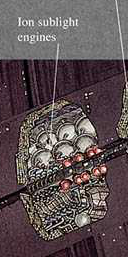In the Star Wars saga, one of the most iconic weapons of the Empire was the Death Star: a self sustained weapons platform the size of a moon, with the capacity to destroy a planet. in A New Hope, we see the first Death Star in close proximity to the planet Alderaan, holding the planet hostage as the Empire tries to deduce the location of the Rebel Alliance's headquarters. In Return of the Jedi, we see the second Death Star in "dry dock" over the forest moon of Endor as it is being constructed.
My question is: How did the Death Star move? I imagine a spherical space station the size of a moon would be utterly massive, requiring a massive amount of thrust to move it. If it was constructed in low orbit of an inhabited planet/moon, the gravitational field would be immense, consisting of the planet/moon's gravity, and the Death Star's own considerable gravity. Breaking that gravitational field would be a massive task, yet we see no thrusters or engines on either Death Star. Were they hidden, stored under the station's surface while not in use? Was the station towed by another vessel?

 (Image from the Death Star Technical Companion, 1st edition, published by West End Games.)
(Image from the Death Star Technical Companion, 1st edition, published by West End Games.)




